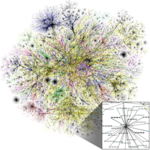Digital divide
This article does not have any sources. (May 2017) |
| Internet |
|---|
 |
|
|
Digital divide is the gap between parts of the world where access to information technology is very different. Developed countries have plentiful internet, mobile phones, computers and Wi-Fi. Other parts of the world do not. It is the difference of people that can access the internet, and the people that cannot.
Problems
[change | change source]A digital divide can be born for many reasons like socioeconomic problems (few people are rich and many are poor), racial problems (there is a majority or a minority that controls the other), or geographical problems (in the cities there are technologies but there are not in rural areas).
Countries on the rich side of the divide include Canada, the United States, Japan, South Korea, Europe and Australasia. They have big communication infrastructure, and most people can afford computers and other technology. On the poor side is Latin America, Africa, and Southeast Asia, where there are many social problems. Technology has a long way to go before getting interest in those countries, because of problems like the price of technology and the fact that sometimes there are not any resources to help.
Inner conflict
[change | change source]In some parts of the world there is a large digital divide. Sometimes it is just in half of a country, or just a region, for example Africa. As with other things like education or transport, some people have things that others don't have. There are big cities where technologies are cheap and there are many villages and rural communities where there is no digital/electronic technology. In this case the digital divide creates other problems. Because a part of the country is rich and another part is poor, there are often problems with trading and connections.
